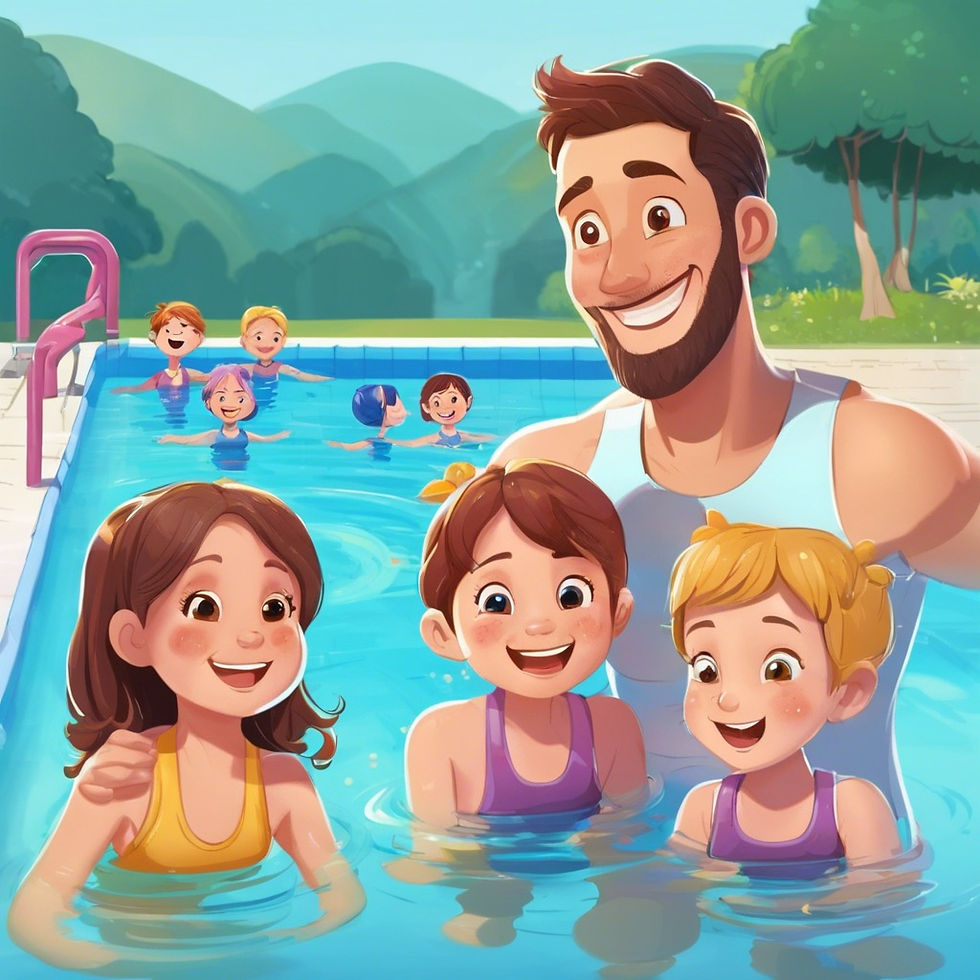
Let’s talk about a growing concern I have: why have swimming lessons for children become so rigid and formulaic? It seems like the joy of learning to swim is being overshadowed by strict routines, barking orders, and the constant demand for "good behavior." Aren’t we missing something critical here?
Children aren’t little robots. They’re not there to follow commands without question. They’re mini humans, full of curiosity, creativity, and unique needs. Treating them like soldiers in the pool not only diminishes the joy of the water but can actually stifle their development. Where is the space for exploration, fun, and learning through play?
Swimming lessons should be about the child, not the adult in charge. It’s not about control; it’s about connection. A good teacher understands that children don’t need to be controlled—they need to be understood. When a child’s needs are met, you’ll see it in their behavior. If a child is acting out or not responding well, maybe it's not the child who’s the problem. Maybe it's the approach.
There are so many layers to teaching kids, and if you're not willing to meet them where they are, you're not truly teaching.
Why have we created a system where swimming lessons for children feel more like boot camps than experiences of joyful learning? We’ve come to expect children to conform to rigid structures, respond to commands immediately, and exhibit perfect behavior. But are we stopping to ask ourselves—what’s driving this approach, and is it truly what children need?
The truth is, we’ve gotten lost in the idea that teaching children means controlling them. This results in lessons where kids are barked at for the smallest missteps, constantly expected to “be on their best behavior,” and made to follow an inflexible script. But children don’t learn best under pressure. They learn when they feel safe, understood, and, most importantly, when they’re having fun.
Swimming is an opportunity for children to connect with their bodies, explore their physical limits, and engage with water in a natural, enjoyable way. Yet, we’ve turned it into a task-driven process that strips away their agency and curiosity. Why should a child have to endure this type of environment, one that expects them to behave like miniature adults?
The key problem is that we’ve forgotten that children are not just smaller versions of us. They are unique beings, each with their own emotional, physical, and developmental needs. They require environments where they feel supported, not dominated. When teachers focus too much on discipline, it creates a power struggle. This is when we see "bad behavior," which is often just a child communicating that their needs aren’t being met.
A truly effective swimming instructor is someone who understands that each child brings something different to the table. It’s about creating a balance between structure and freedom. Children need to feel like they can explore and be themselves while also being guided. When teaching becomes too regimented, it’s no longer about the child’s growth—it’s about the adult’s need for control.
Moreover, when lessons focus solely on following orders, we forget to nurture essential skills like self-awareness, confidence, and independence. Swimming is not just about learning strokes; it’s about becoming comfortable in the water and discovering the joy and possibilities that come with it. A child who feels empowered will naturally want to learn more, push themselves further, and behave in a way that reflects that self-assuredness.
In the end, a child’s behavior is often a mirror of how they are being treated. If they are being barked at or forced into routines that don’t fit them, they will push back. Instead of blaming the child for not “behaving,” we need to reconsider the methods we’re using to teach them. Are we addressing their needs? Are we fostering a love for the water or simply enforcing a rigid set of rules? We need to remember that it’s not about making children fit into a mold; it’s about creating an environment where they can grow, explore, and thrive.
If we want children to become strong swimmers and confident individuals, it’s time to rethink the way we approach teaching them. They don’t need more rules—they need more understanding.
Let’s dig even deeper because this issue highlights a fundamental problem in the way we approach children's learning, not just in swimming but in so many areas of their lives.
It’s as if we’ve forgotten that learning—especially for young children—is a messy, nonlinear process. Children naturally thrive when given the opportunity to explore, experiment, and learn through play. Yet, the structure of many swimming lessons has become robotic and stiff, focusing too heavily on ticking boxes: perfect form, compliance, and controlled behavior.
But here’s the kicker—children aren’t wired that way. They’re not built for this one-size-fits-all approach. They come in with their unique personalities, their fears, their excitement, and their own ways of processing the world. When we push them into a regimented system, we’re doing more harm than good. We’re suppressing their natural instincts, curiosity, and enthusiasm for learning. Forcing them to comply with strict routines might get short-term results, but at what long-term cost?
Consider this: learning to swim should be a liberating experience for children. The water is a place for discovery—learning to float, discovering their balance, and feeling the resistance of water. But when lessons become regimented, the water becomes a place of stress and anxiety. Children who could be finding joy in the water are instead worrying about following directions, getting in trouble, or performing perfectly.
The whole idea of teaching children through orders and rigidity is a relic of outdated thinking. Modern pedagogy recognises that children are whole beings with emotional needs, and behavior isn’t just about discipline—it’s a form of communication. When a child is "misbehaving" in a swimming lesson, it’s often because they are overwhelmed, scared, bored, or disengaged. Instead of recognising these signals, a regimented teaching style shuts down those emotional expressions. The message becomes, “Your feelings are not important—just do what you're told.”
This approach can have damaging effects on a child's relationship with the water—and with learning in general. Children who feel constantly controlled are less likely to take risks or push their limits, two key elements in learning to swim (or learning anything, really). They don’t just lose the joy of the experience; they lose confidence in themselves. Over time, they start to associate swimming with stress, compliance, and performance rather than freedom and fun.
And here’s the irony—children learn best when they feel safe, relaxed, and in tune with their emotions. A child who feels heard and respected is much more likely to follow instructions and engage in the learning process. When they know their feelings matter, they are empowered. They start to see the pool as a place where they can express themselves, not just another environment where they have to obey.
Teachers who rely on strict structures and commands often forget that swimming is more than just learning to swim; it’s about building trust between the child and the water. It’s about the instructor fostering an environment where children can be vulnerable and open, where their natural instincts are honored, and where they feel free to make mistakes and try again.
A child who splashes too much, moves too slowly, or gets distracted isn’t “misbehaving”—they’re learning! And every child learns at a different pace and in a different way. What works for one might not work for another. The best swimming teachers understand this and are willing to adapt, recognising that children need flexibility, patience, and encouragement to build the confidence they need to swim independently.
There is also the question of why we expect young children to always be on their best behavior in lessons. Adults have off days—so why do we expect kids to be perfectly focused and well-behaved all the time? A child who’s acting out might just be tired, hungry, or emotionally overloaded. Rather than forcing them to comply, we need to offer compassion, flexibility, and understanding. That’s how we help them love the water.
In short, the problem with regimented swimming lessons is that they’re focused on the wrong things. They prioritise control over connection, compliance over curiosity, and short-term obedience over long-term confidence. If we want to raise strong, capable swimmers, we need to stop treating children like little adults who must be forced into routines. We need to meet them where they are—on their level, with their needs, emotions, and development in mind. It’s not about being in control of them; it’s about helping them feel in control of themselves in the water. Only then will we see the true magic of learning unfold.

In conclusion, the rigid, regimented approach to swimming lessons is doing a disservice to children. By prioritising obedience and control over individuality and exploration, we risk turning the joy of learning into a chore. Children are not small adults; they are complex, emotional beings with unique needs that require patience, understanding, and flexibility. When we impose strict rules and expect perfect behavior at all times, we miss the opportunity to connect with them on a deeper level and foster a genuine love for the water.
It’s time to rethink how we approach teaching children to swim. Rather than focusing on discipline and structure, we should be creating environments that encourage curiosity, play, and self-expression. By meeting children where they are, supporting their emotional needs, and offering them the freedom to learn at their own pace, we can empower them to build not just swimming skills but also confidence, independence, and a lifelong relationship with the water.
In the end, it’s not about making children fit into rigid molds—it’s about adapting our teaching methods to help them grow into confident, capable swimmers, with a true love for the water.
Join me in our mission to promote swimming lessons as fostering independence, creativity, and resilience in every child we reach. Ready to be part of the change? Connect with us today!


What an amazing read this was ! I'm new to the swim teacher industry and remember having this exact experience when I was a young child , feeling swimming become a stressful chore where I had to perform well and eventually not enjoying it.
I try to adapt a style of teaching you speak about in this article, where I try to understand the students and come down to their level a bit. It's really good to hear I've been on the right track !